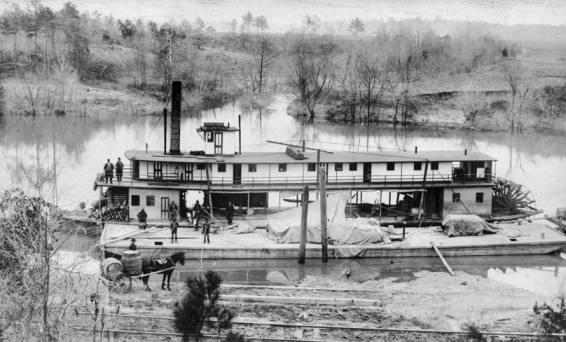Moncure, North Carolina: founded in 1881, populated by less than 1,000 people in an area under five square miles – and once the westernmost inland port in North Carolina, connected to the sea via 200 miles of water in the form of the Cape Fear River.
Before North Carolina was crisscrossed by well over 200,000 miles of public roads, large-scale transport was tricky business. Bulk transportation using railroads and steamships was the most efficient method to transport mail, goods and people over long distances.
The first steamship to travel North Carolina’s inland waterways was the Norfolk, named for the city it was built in, which set sail in 1818. Three weeks behind the Norfolk, the first steamship built in North Carolina – the Henrietta – was launched. The Henrietta could carry 100 tons of cargo and up to 30 passengers, and monopolized trade between Fayetteville and Wilmington.
The Henrietta proved to be a prototype for future North Carolina steamers, with a flat-bottom hull to minimize draft, a wheel situated at the stern rather than the side – in order to safely navigate winding, wooded North Carolina rivers – and two-story decking that accommodated freight and passengers alike.
The steamship was the dominant mode of transportation from the coast inland, far outpacing wagons in terms of efficiency. Steamers continued to paddle up and down rivers carrying mail, passengers and cargo until well-maintained roads were built and internal combustion engines became relatively common in the 1920s. Throughout the 1800s, the North Carolina General Assembly approved a variety of ventures and measures to enhance inland waterways, improve navigation and use the transportation of Chatham County coal downriver to turn a tidy profit. During this time, Moncure was a central point of communication, trade and travel as North Carolina’s westernmost inland port.

Captain Nathan Ramsey’s map of Chatham County, courtesy of North Carolina State Archives
Situated conveniently close to the confluence of the Haw and Deep rivers – where both bodies of water come together to form the Cape Fear river – Moncure was positioned as the last town easily accessible by steamships capable of carrying considerable amounts of passengers and cargo. The town of Moncure was founded after a switching yard and railway station were built to the north of Haywood, an ambitious settlement that applied to be both the state capital and permanent home to the University of North Carolina before eventually transferring most of its business and population to up-and-coming Moncure. Haywood laid the groundwork for healthy trade routes along inland waterways, but both Haywood and Moncure were predated by town called Lockville.
Lockville was founded in 1740, and while the town was too early to capitalize on the steamship boom that would come in later decades, it provided a convenient framework for future settlements to follow. The founders of Lockville recognized the potential value of the confluence of rivers, and while the town itself eventually was absorbed by Moncure, the original Lockville tavern stood until it was destroyed by a flood in the late 19th century.
The tavern and town of Lockville were famous among locals for legends of mermaids bathing on the sandbar where the Deep and Haw rivers merged to become the Cape Fear River. According to tall tales of the time, mermaids sang on the sandbar and splashed in the river at night. The mermaids – being vain creatures, of course – liked to swim upstream and wash their hair free of salt in the fresh water.
Whether drawn by mermaids, business opportunities or the prospect of a relaxing holiday, travelers found an ideal vacation destination just under 10 miles from Moncure in the form of Pittsboro. Summertime travelers from the coast, weary of swarms of mosquitoes and other insects, treated Pittsboro as a resort town. These holiday crowds provided a much-needed boost to the local economy that, paired with the influx of cash from trade routes along rivers, made Chatham County into the area we recognize today.
(cover photo: “The river steamer Cape Fear docked at Fayetteville, ca. 1875” in Robert Preston Harriss Papers, Rare Book, Manuscript, and Special Collections Library, Duke University)


